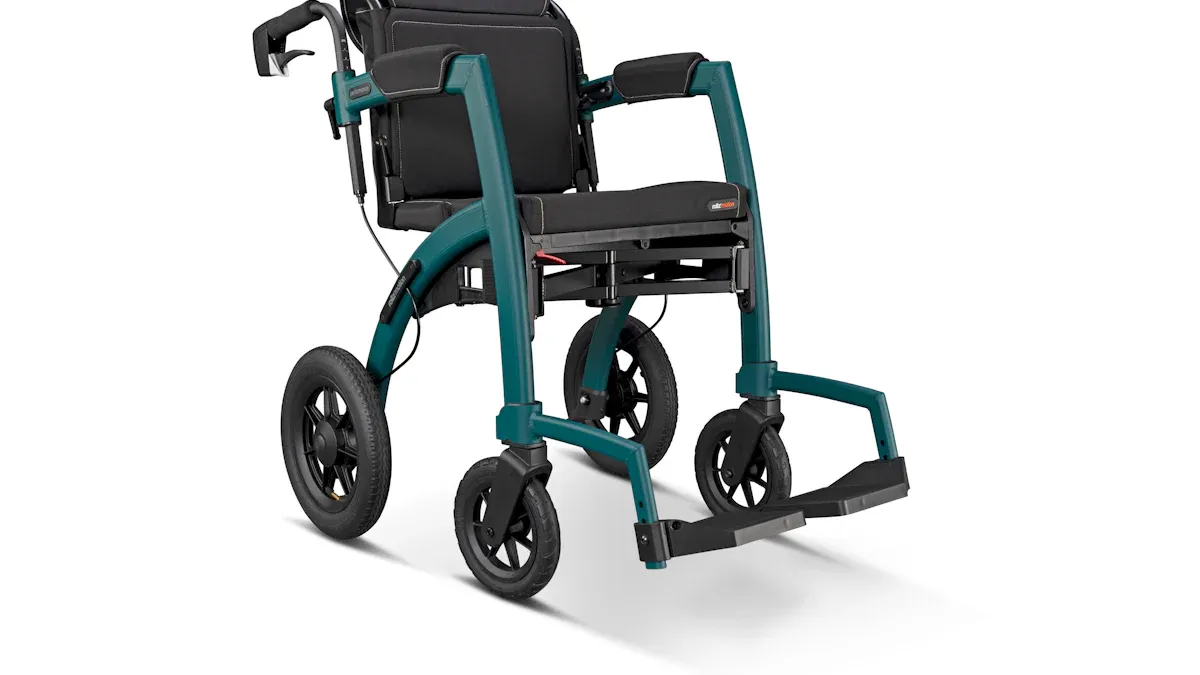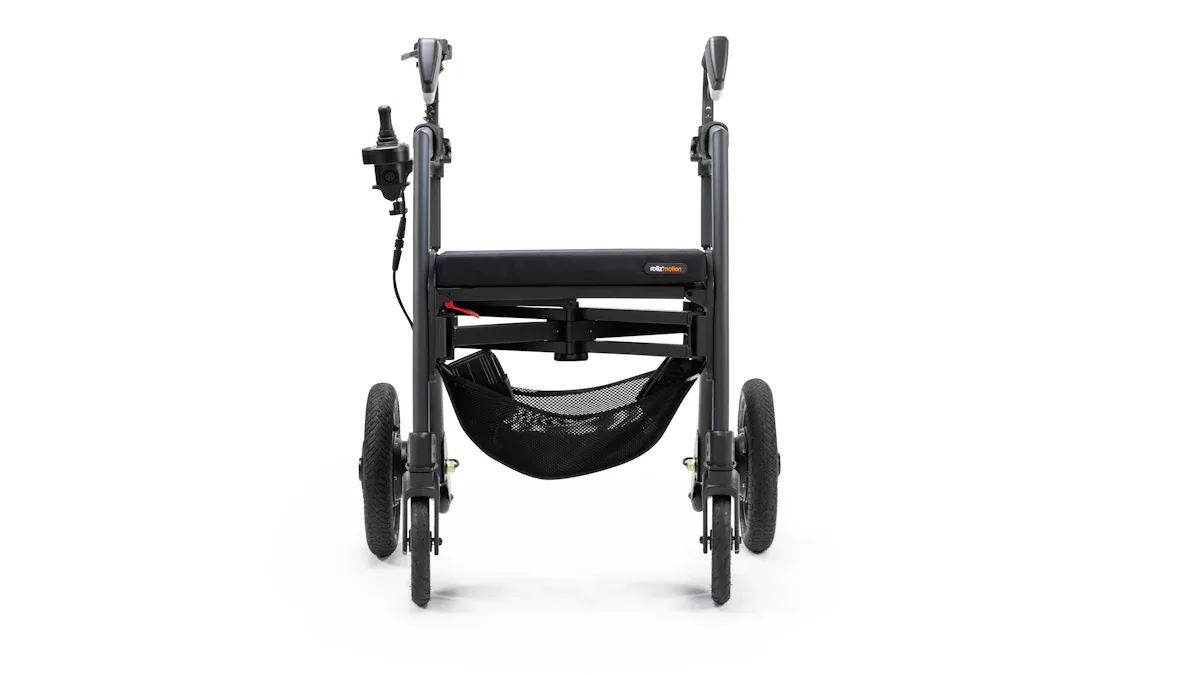
Folding electric wheelchairs make life easier by offering unmatched portability. Models like the WHILL Model F fold in under three seconds and weigh under 53 lbs, while others, like the EW-M45, weigh just 59 lbs. With global demand growing at an 11.5% annual rate, these foldable electric wheelchairs are transforming mobility solutions.
Key Takeaways
- Foldable electric wheelchairs help users move easily and travel better.
- Strong but light materials, like carbon fiber, make them last longer and simple to carry.
- Picking the best foldable wheelchair means thinking about weight, storage, and how it fits with travel options.
Types of Folding Mechanisms in Electric Wheelchairs

Compact folding designs
Compact folding designs are ideal for users who prioritize portability and convenience. These wheelchairs collapse into a smaller size, making them easier to store in tight spaces like car trunks or closets. Their design focuses on simplicity, allowing users to fold and unfold the wheelchair quickly without requiring tools or assistance.
Compact designs are particularly popular among users who travel frequently or live in urban areas where space is limited. They also appeal to caregivers, as the lightweight structure reduces the effort needed to transport the wheelchair.
| Design Feature | Benefit | Usage Statistics |
|---|---|---|
| Compact and foldable | Easier to transport and store | Most commonly issued design until 2000, preferred by therapists and users |
| Improved maneuverability | Suitable for various terrains | Users with active lifestyles benefit more from designs that allow biomechanical adjustments |
| Cultural and aesthetic acceptance | More acceptable to users, influencing choice | Design was often selected out of habit by therapists, despite limitations |
| Cost-effective | Lower cost led to preference despite functional limitations | Cheaper option influenced selection due to funding challenges |
| Limited function for active users | Basic design may restrict mobility and function for more active users | Users with higher activity levels experienced poorer overall function with this design |
These designs strike a balance between affordability and functionality, making them a practical choice for many users.
Lightweight folding options
Lightweight folding electric wheelchairs are crafted with materials like carbon fiber and aluminum to reduce weight without compromising durability. These models are perfect for users who need a wheelchair that’s easy to lift and carry.
- Carbon fiber offers a high strength-to-weight ratio, ensuring the wheelchair remains sturdy while being lightweight.
- It resists corrosion, making it suitable for humid environments or outdoor use.
- Unlike aluminum, carbon fiber maintains its performance in extreme temperatures, preventing cracks or weakening over time.
| Metric | Carbon Fiber | Aluminum |
|---|---|---|
| Strength-to-Weight Ratio | High | Moderate |
| Corrosion Resistance | Excellent | Poor |
| Thermal Stability | High | Moderate |
| Long-term Durability (ANSI/RESNA tests) | Superior | Inferior |
These features make lightweight folding options a reliable choice for daily users who value durability and ease of transport.
Disassembly-based folding mechanisms
Disassembly-based folding mechanisms take portability to the next level. Instead of folding into a compact shape, these wheelchairs can be broken down into smaller components. This design is especially useful for users who need to fit their wheelchair into tight spaces or travel with limited storage options.
A case study highlights the effectiveness of this mechanism. The wheelchair’s frame, made from aluminum alloy, ensures a lightweight structure while maintaining durability. Electric motors are integrated seamlessly, and a locking mechanism secures the wheelchair during use. These features make disassembly-based designs both practical and reliable for users who prioritize transportability.
Users often choose this option for long-distance travel or when storage space is extremely limited. While disassembly requires a bit more effort than traditional folding, the flexibility it offers makes it a worthwhile trade-off.
Benefits of a Folding Electric Wheelchair

Portability for travel
Traveling with a wheelchair can be challenging, but a folding electric wheelchair makes it much easier. These wheelchairs are designed to collapse into a compact size, allowing users to store them in car trunks, airplane cargo holds, or even train compartments. This portability gives users the freedom to explore new places without worrying about bulky equipment.
A study by Barton et al. (2014) revealed that 74% of users relied on mobility devices like folding electric wheelchairs for travel. The same study found that 61% of users felt these devices were easier to use, while 52% reported greater comfort during trips. Another survey by May et al. (2010) highlighted how these wheelchairs enhanced mobility and independence, improving users’ overall well-being.
| Survey Source | Sample Size | Key Findings |
|---|---|---|
| Barton et al. (2014) | 480 | 61% found scooters easier to use; 52% found them more comfortable; 74% relied on scooters for travel. |
| May et al. (2010) | 66 + 15 | Users reported enhanced mobility, increased independence, and improved well-being. |
These findings show how folding electric wheelchairs empower users to travel more confidently and comfortably.
Space-saving storage
One of the standout features of a folding electric wheelchair is its ability to save space. Whether at home, in a car, or at a hotel, these wheelchairs can be folded and stored in tight spaces. This is especially helpful for people living in apartments or homes with limited storage areas.
Unlike traditional wheelchairs, which often require dedicated storage rooms, folding models can fit into closets, under beds, or even behind doors. This convenience ensures that users can keep their wheelchairs nearby without cluttering their living spaces. For families or caregivers, this feature reduces the stress of finding storage solutions, making daily life more manageable.
Ease of use for caregivers and users
Folding electric wheelchairs are not just user-friendly; they’re also designed with caregivers in mind. Many models feature simple mechanisms that allow quick folding and unfolding, often with just one hand. This ease of use means caregivers can focus more on assisting the user rather than struggling with the equipment.
For users, the intuitive design ensures they can operate the wheelchair independently. Lightweight materials and ergonomic controls make these wheelchairs easy to maneuver, even in crowded or narrow spaces. Whether it’s navigating a busy airport or moving through a small apartment, these wheelchairs adapt to the user’s needs seamlessly.
Tip: When choosing a folding electric wheelchair, look for models with automatic folding mechanisms. These can save time and effort, especially during travel or emergencies.
By combining portability, space-saving features, and ease of use, folding electric wheelchairs offer a practical solution for enhancing mobility and convenience in everyday life.
Key Considerations When Choosing a Folding Electric Wheelchair
Weight and durability
Weight and durability play a big role in choosing the right folding electric wheelchair. Lightweight models are easier to lift and transport, but they must also be strong enough to handle daily use. Engineers test these wheelchairs for strength, impact resistance, and fatigue to ensure they meet durability standards.
| Test Type | Description | Failure Classification |
|---|---|---|
| Strength Tests | Static loading of armrests, footrests, handgrips, push handles, tipping levers | Class I and II failures are maintenance issues; Class III failures indicate structural damage requiring major repairs. |
| Impact Tests | Conducted with a test pendulum on backrests, hand rims, footrests, castors | Class I and II failures are maintenance issues; Class III failures indicate structural damage requiring major repairs. |
| Fatigue Tests | Multidrum test (200,000 cycles) and curb-drop test (6,666 cycles) | Class I and II failures are maintenance issues; Class III failures indicate structural damage requiring major repairs. |
Brushless DC permanent magnet motors are often preferred for their durability and efficiency. These motors last longer and help extend battery life, making them a smart choice for users who need reliable performance.
Compatibility with transportation methods
A folding electric wheelchair should fit seamlessly into various transportation systems. Public transport regulations ensure accessibility for wheelchair users, but not all models are equally compatible.
- Sec. 37.55: Intercity rail stations must be accessible for individuals with disabilities.
- Sec. 37.61: Public transportation programs in existing facilities must accommodate wheelchair users.
- Sec. 37.71: New buses purchased after August 25, 1990, must be wheelchair-accessible.
- Sec. 37.79: Rapid or light rail vehicles purchased after August 25, 1990, must meet accessibility standards.
- Sec. 37.91: Intercity rail services must provide designated spaces for wheelchairs.
When choosing a wheelchair, users should check its compatibility with these systems. Features like compact folding mechanisms and lightweight designs make it easier to navigate public transport and store the wheelchair during travel.
Battery and power system integration
Battery performance is another critical factor. Folding electric wheelchairs rely on efficient power systems to deliver smooth operation and long-lasting use. Lithium-ion batteries are popular for their lightweight design, faster charging, and extended range.
| Battery Type | Advantages | Limitations |
|---|---|---|
| Lead-Acid | Established technology, cost-effective | Heavy, limited range, long charging time |
| Lithium-Ion | Lightweight, longer range, faster charging | Higher cost, safety concerns |
| Nickel-Zinc | Potentially safer, environmentally friendly | Small cycle life in low power situations |
| Supercapacitor | Fast charging, high power density | Limited energy storage capacity |
Projects like the development of Nickel-Zinc and supercapacitor hybrid systems aim to improve battery safety, environmental impact, and charging speed. These advancements help users enjoy better mobility and reliability in their daily lives.
Folding electric wheelchairs simplify mobility for users who value convenience. Their diverse folding mechanisms, like compact designs or disassembly options, cater to unique needs. Choosing the right model involves weighing factors such as weight, storage, and transport compatibility. These wheelchairs empower users to navigate life with greater ease and independence.
FAQ
Can all electric wheelchairs be folded?
Not all electric wheelchairs fold. Some models prioritize stability or advanced features over portability. Always check the product specifications before purchasing.
How long does it take to fold an electric wheelchair?
Most folding electric wheelchairs collapse in seconds. Models with automatic mechanisms fold faster, while manual designs may take slightly longer.
Are folding electric wheelchairs durable?
Yes, folding electric wheelchairs use strong materials like aluminum or carbon fiber. They undergo rigorous testing to ensure durability for daily use.
Tip: Look for models with ANSI/RESNA certifications for added reliability.
Post time: Jun-03-2025
